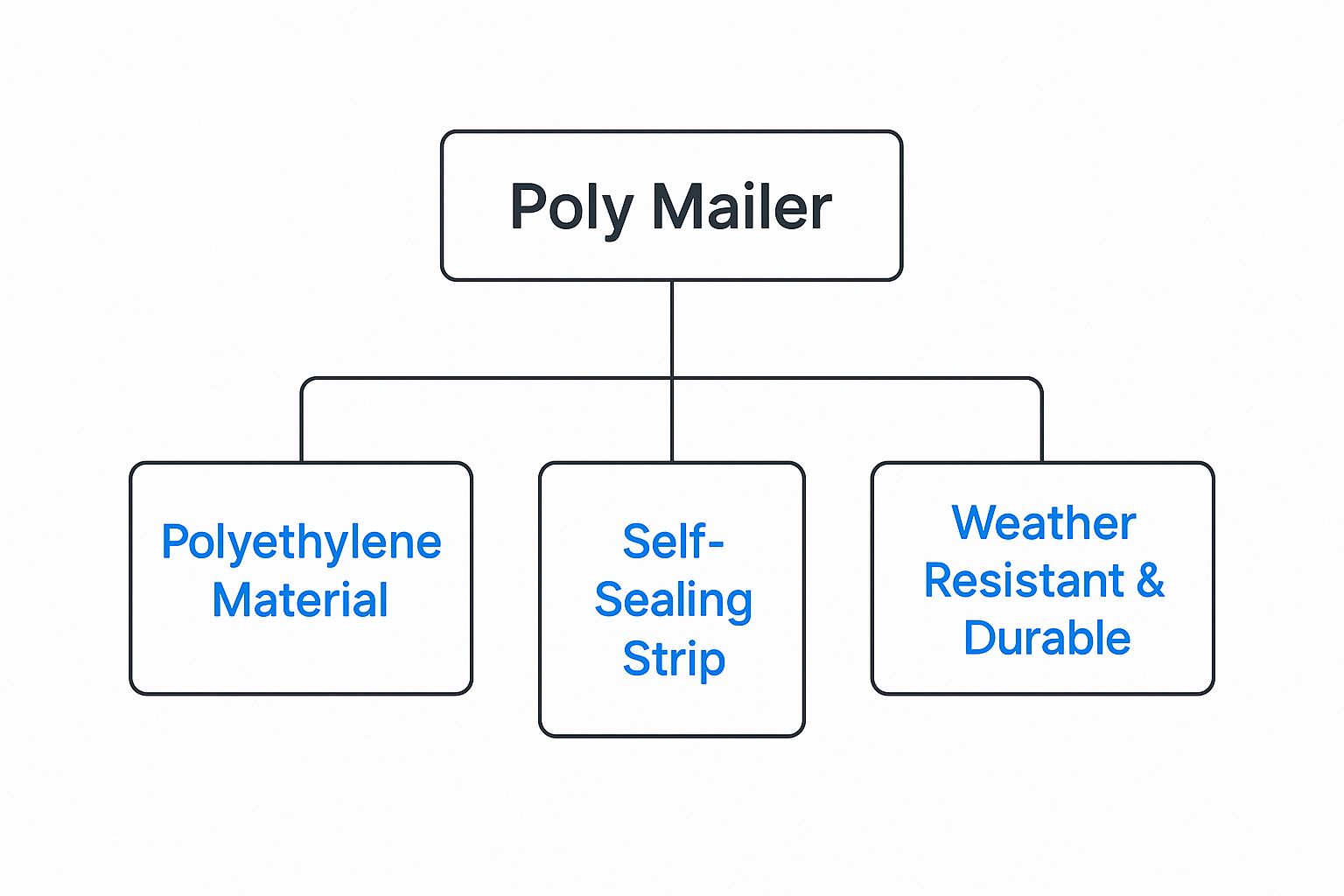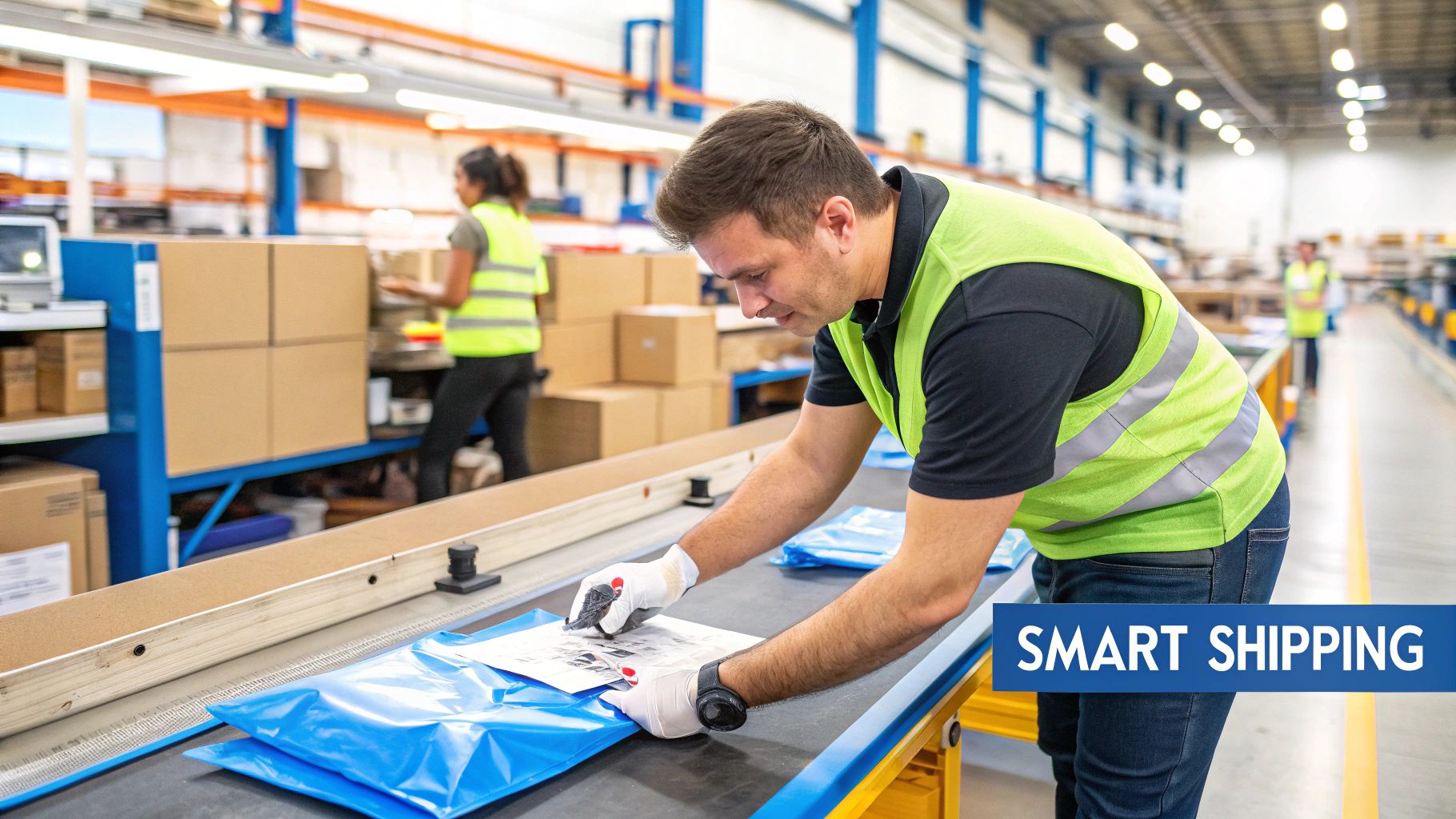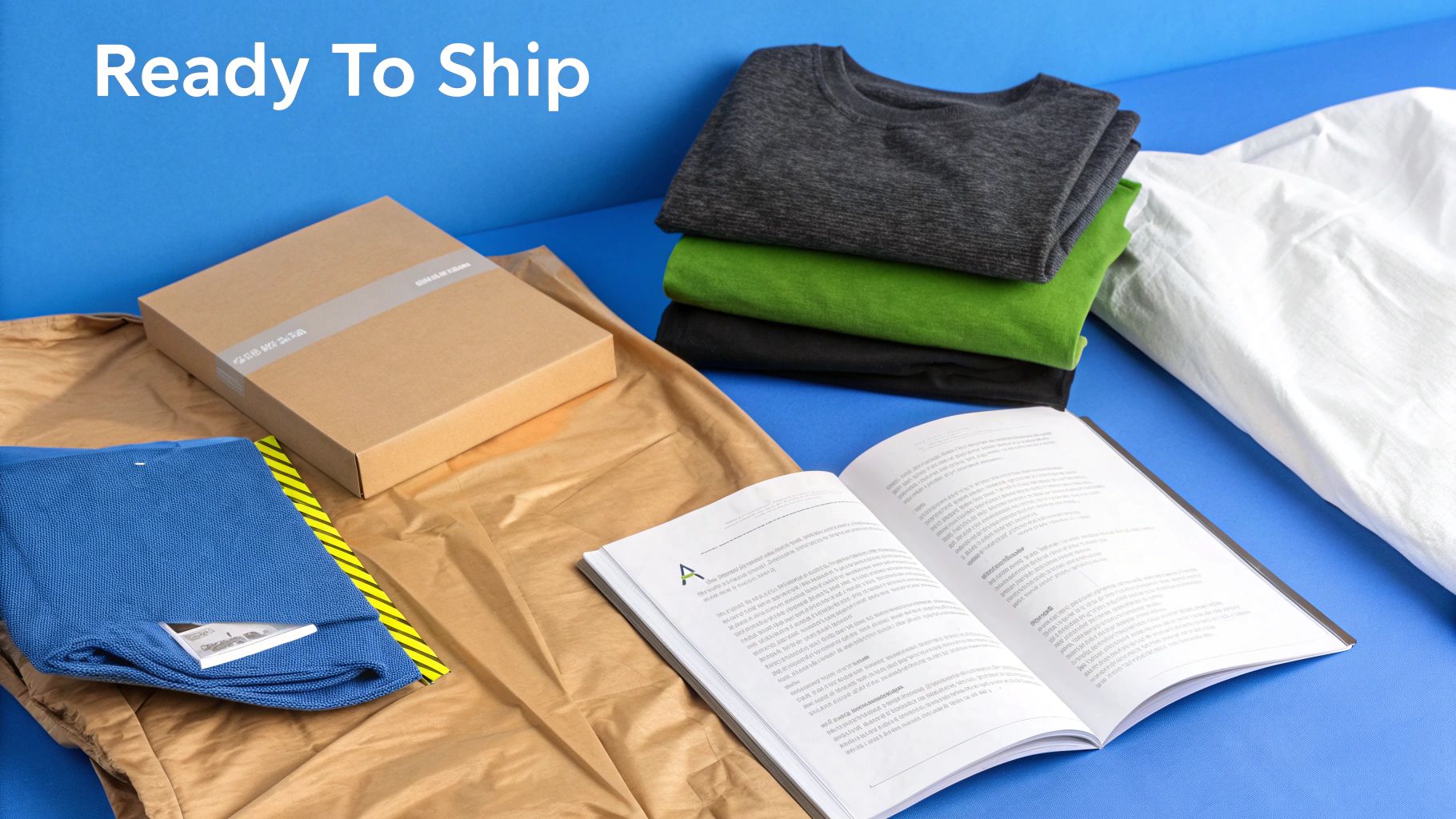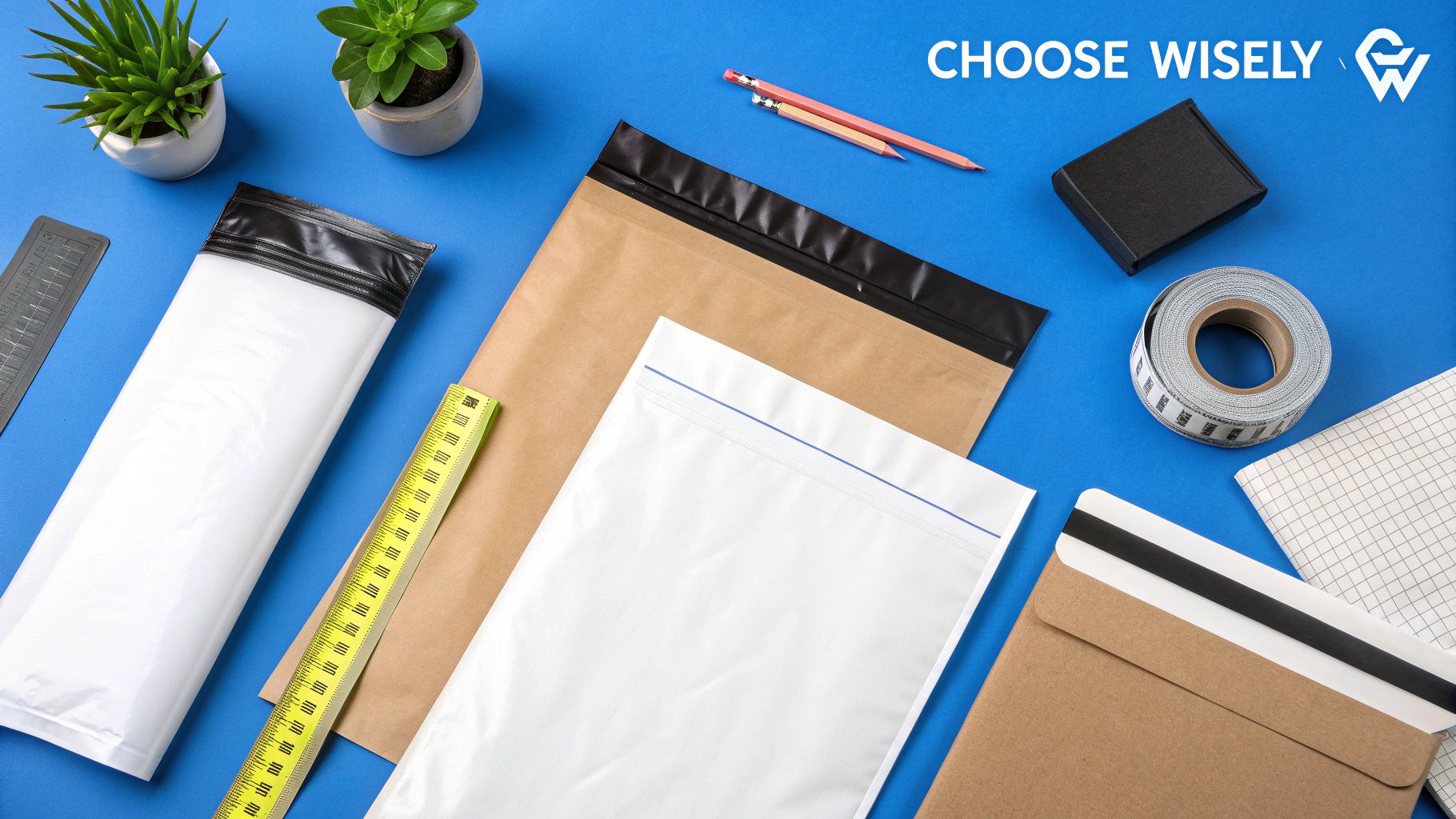If you've ever received a t-shirt or a book from an online store, chances are it arrived in a poly mailer. Simply put, a poly mailer is a lightweight but surprisingly tough plastic bag made specifically for shipping non-fragile goods.
These aren't just any plastic bags, though. They’re engineered from durable polyethylene to be water-resistant, tear-proof, and feature a super-sticky self-sealing adhesive strip. This makes them a go-to, cost-effective alternative to bulky cardboard boxes for countless e-commerce brands.
Think of a poly mailer as a high-tech, flexible envelope built for the rigors of modern shipping. It ditches the weight and bulk of a traditional box in favor of a sleek, protective layer perfect for items like clothing, books, or soft accessories that don't need rigid walls to keep them safe. What seems like a simple bag is actually a strategic tool for any online store looking to ship smarter.
Their real magic is in the construction. The tough polyethylene material acts as a shield against moisture and punctures, giving you peace of mind that your products will arrive in great shape. And unlike boxes that demand a wrestling match with packing tape, the simple peel-and-seal strip on a poly mailer makes packing orders a breeze, saving precious time in the fulfillment process.
This infographic gives a quick visual breakdown of what makes a poly mailer tick.

As you can see, the combination of durable material and a secure seal creates an incredibly reliable shipping solution.
To give you a clearer picture, here’s a quick summary of a poly mailer's key characteristics.
This table highlights why so many businesses have made the switch from boxes for a large portion of their shipments.
Now, while poly mailers are incredibly versatile, it's worth noting they aren't the same as all other types of plastic bags used in shipping. If you want to dive deeper into the nuances, you can explore this guide to https://www.simplfulfillment.com/define/poly-bags to learn more.
Of course, smart e-commerce isn't just about the physical packaging. A successful brand also needs a solid digital foundation. Getting the technical details right, like a proper Shopify pixel integration, is just as crucial for tracking performance and growth as choosing the right mailer is for delivering a great customer experience.
At its heart, a poly mailer is a simple but effective piece of engineering. The secret sauce is a specific plastic called low-density polyethylene, or LDPE. This isn't your average plastic bag material. It’s selected for a unique molecular structure that delivers an incredible combination of flexibility and strength.
Think of it like a microscopic chainmail armor for your products. This structure gives it the toughness to resist the tears and punctures that are an inevitable part of the shipping journey. On top of that, LDPE is naturally water-resistant, creating a reliable barrier against rain, snow, or a misplaced coffee spill. It’s this blend of durability and weather-proofing that has made poly mailers a go-to for protecting soft goods like apparel. Every mailer also comes standard with a tamper-evident, peel-and-seal adhesive strip, so you know the package stays shut until your customer opens it.
Of course, one size doesn't fit all in e-commerce. That's why poly mailers come in a few specialized flavors, each designed for a different job. Matching the right mailer to your product is a small but critical part of a smart shipping strategy. You can dig even deeper into the pros and cons of popular packaging materials in our detailed guide.
Here are the main types you'll run into:
One of the most important specs to understand is a mailer's mil thickness. One mil is simply one-thousandth of an inch. A higher mil count means a thicker, tougher, more puncture-resistant bag. Most standard poly mailers fall in the 2.0 to 3.0 mil range, which hits the sweet spot between solid protection and cost-effectiveness for most everyday shipping needs.
Beyond their simple plastic construction, poly mailers offer some serious strategic advantages that hit an e-commerce brand right where it counts: the bottom line and operational efficiency. For any growing business, these benefits aren't just minor perks. They're essential for staying competitive. The decision to grab a poly mailer instead of a cardboard box usually comes down to three core business drivers that smart brands can't ignore.

First and foremost is cost efficiency. Shipping carriers charge based on weight and size, and the featherlight nature of poly mailers gives you a huge advantage. When you ditch the heavy, bulky cardboard of a box, you can drastically cut down on shipping fees for each package. That's a saving that multiplies fast across thousands of orders. You can find more ways to wrangle those shipping fees in our complete guide on optimizing e-commerce shipping costs.
This cost-saving power is a huge reason for their explosive growth. The U.S. mailer packaging market was valued at USD 6.82 billion in 2024. Projections show it skyrocketing to USD 24.38 billion by 2033, an expansion fueled almost entirely by the e-commerce boom. You can read more about this market's rapid expansion on Grandviewresearch.com.
The second key benefit is a major boost in operational speed. In a busy warehouse, time is money. A poly mailer’s simple peel-and-seal adhesive strip completely eliminates the need for tape guns and fumbling with box assembly. This allows your fulfillment team to pack orders in a fraction of the time. That streamlined process means more orders out the door per hour, which directly improves labor productivity.
Finally, poly mailers are a branding powerhouse. Unlike a plain brown box, their entire surface is a blank canvas just waiting for your brand’s personality.
By using custom-printed mailers, you turn every shipment into a mobile billboard. A vibrant, well-designed mailer creates a memorable unboxing experience from the moment it lands on a customer's doorstep, reinforcing brand identity and excitement before the package is even opened. This makes a strong first impression and helps your business stand out in a crowded market.

Alright, so we know what a poly mailer is. The next logical question is, what should you actually be putting inside one? The golden rule is simple: stick to non-fragile, durable items that don't need the rigid, structural protection of a box.
Think of it this way: if you can drop the item on the floor from waist height without panicking, it's probably a great candidate for a poly mailer. This quick test is the easiest way to separate products that can benefit from a mailer's lightweight efficiency from those that absolutely need a box to arrive in one piece.
Poly mailers are the undisputed champions for shipping soft goods and other resilient products. Their flexibility and tear-resistance make them a perfect match for anything without sharp edges or delicate parts.
Here’s a look at the most common items that thrive in a poly mailer:
Crucial Reminder: A poly mailer’s job is to protect against dirt, moisture, and tearing—not impact. It offers virtually no cushioning on its own.
On the flip side, some products should never see the inside of a standard poly mailer. Trying to ship fragile goods this way is a recipe for disaster, leading to damaged inventory, unhappy customers, and costly returns.
Always grab a sturdy box with the right amount of filler for these items:
Picking the right poly mailer isn't just another item on your supplies checklist. It’s a decision that directly protects your products and shapes how customers see your brand the moment their order arrives. Getting it right means finding the perfect balance of size, strength, and style to make sure every single shipment is both secure and impressive.
Think of it like tailoring a suit for your products—a perfect fit makes all the difference.

This level of detail is exactly why the global polyethylene mailers market was already valued at USD 3,450.3 million back in 2025 and is only expected to climb. As more e-commerce brands catch on to the power of high-quality, custom packaging, the demand for better flexible packaging materials is booming. You can dig into all the details on these market projections on Futuremarketinsights.com.
First things first: get the size right. A mailer that’s way too big is wasteful and looks sloppy. On the other hand, one that’s too small is a recipe for a burst seam and a damaged product. Just measure your item's length, width, and height, then add about an inch to each side to get a snug, professional fit.
Next up is durability, which all comes down to mil thickness. One mil is simply one-thousandth of an inch. Here’s a quick cheat sheet for matching the mailer to your merch:
Beyond just getting your product from A to B, the right features can make the unboxing experience so much better. Look for mailers with a built-in bubble lining for semi-fragile items, or even a simple perforated tear strip that saves your customer from wrestling with the package. It's the little things that count.
And finally, don't ever underestimate the power of a good first impression. Custom-printed poly mailers transform a boring delivery into a memorable brand moment. Slapping your logo, brand colors, or a unique pattern on that bag instantly sets you apart from competitors using plain, generic packaging. This is a crucial touchpoint that reinforces your brand identity and builds excitement before they even see what's inside.
Even after covering the basics, a few practical questions always pop up when brands first think about switching to poly mailers. Let's tackle the most common ones head-on so you can move forward with total confidence.
These are the real-world concerns we hear all the time, from environmental impact to the simple mechanics of getting a label to stick. Getting these details right from the start makes integrating poly mailers into your fulfillment process a breeze.
The short answer is yes, but there's a crucial catch. Most standard poly mailers are made from #4 LDPE plastic, which is absolutely recyclable. The important thing to know is that they can't just be tossed into your regular curbside bin with plastic bottles and cardboard.
These mailers need to be dropped off at special collection points for plastic films. You've probably seen these bins near the entrance of major grocery stores and retailers like Target or Walmart.
For brands putting sustainability at the forefront, there are even better options available. Many suppliers now offer poly mailers made from 100% recycled content or from plant-based materials that are commercially compostable. These let you keep the benefits of a lightweight mailer while significantly shrinking your environmental footprint.
Absolutely. That smooth, non-porous surface is practically made for shipping labels. Whether you're using thermal or standard paper labels, they are designed to form a strong bond with the polyethylene material.
The key is simply applying the label correctly. For a perfect stick every time:
That's it. A properly applied label will have no problem surviving the journey through automated sorting machines and rough handling in transit.
This is the most important question, and the answer comes down to one word: fragility. A poly mailer is a champ at protecting products from moisture, dirt, and punctures. It is not designed to protect against impact or crushing.
Think of it this way: a poly mailer is like a heavy-duty raincoat, while a box is like a suit of armor.
The rule of thumb is simple. If an item could break, crush, or get bent out of shape from being dropped or having a heavier package tossed on top of it, it belongs in a box with proper padding.
Always opt for a box for items like:
When in doubt, err on the side of caution. A box with the right void fill provides the structural integrity a poly mailer just can't offer, protecting both your product and your brand's reputation.
Ready to streamline your shipping with smart packaging solutions and expert fulfillment? At Simpl Fulfillment, we handle the logistics so you can focus on growing your brand. Learn how our end-to-end 3PL services can transform your operations.